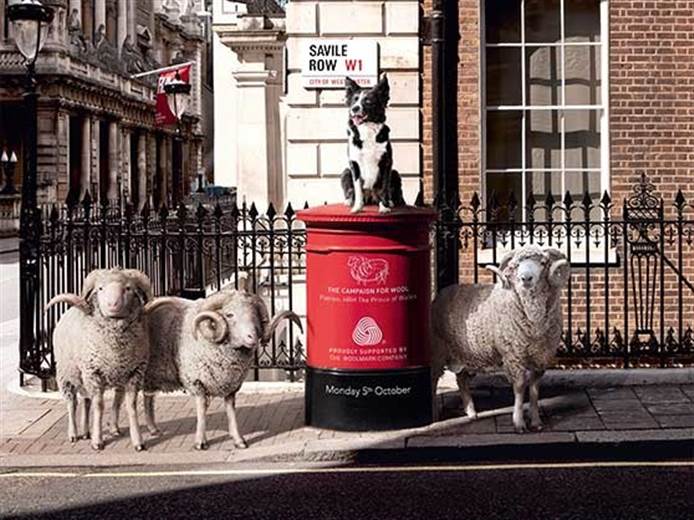Wool association says report risks loss of faith in textile industry
27/07/2017

It says the Pulse of the Fashion Industry report, put together by the Copenhagen Fashion Summit organisers Global Fashion Agenda and The Boston Consulting Group, suggests brands should choose polyester over conventional cotton but that this overlooks several points.
Man-made materials are made from non-renewable resources, it argues, and there is some evidence that the growth in athleisure might be increasing plastic microparticles washed into the sea, as these textiles are washed. Although these are mentioned in the report, they are not given enough credence, it said.
IWTO said: “Not only do such rankings disadvantage wool and other natural fibres, but they have the potential to mislead consumers and risk a loss of faith in the industry and data provider.”
The Pulse Report scored the industry on its environmental and social performance and was given was 32 out of 100.
“Wool has a long history of recycling, and research suggests wool garments are worn for longer and retained for longer than those made of other fibres," counters IWTO. "Wool growers work hard to care for their sheep and land on which they graze, and there is evidence of significant carbon sequestration in the trees and shrubs on sheep farms, which mitigates the effects of greenhouse gases. Holistic land practitioners will also tell you how livestock like sheep promote biodiversity and prevent desertification.”
The Sustainable Apparel Coalition supplied the data for the Pulse Report through its Higg Index. The rankings in the Pulse Report were made using data from the raw materials stage of SAC’s Footprint Tool, rather than including the manufacture, consumer use, reuse and recycling and disposal.
“The most serious problem with the Pulse Report is that it presents a ranking of fibre types without the required data and analysis,” says Geoff Kingwill, chair of the Sustainable Practices Working Group of IWTO.
“There are very clear rules about how to make comparisons of fibre products, particularly to the public. This problem is compounded by failure to make clear that the data the ranking relies upon is based in part on preliminary data. In addition, the ranking is based on just one stage – the first of several stages – of the life cycle of the fibre.”
The report was published in May as a guide to make the fashion industry more sustainable.
It said: “We calculate that reducing conventional cotton by 30% can yield more than €18 billion in annual water savings. Polyester, more than any other alternative, has the cost efficiencies and production scale to be a practical substitute. Polyester already makes up most of the global textile fibre mix, and after decades of development, we can make it with characteristics resembling those of cotton.
“Polyester is no perfect answer, of course. It comes with its own challenges. In a 2017 study, it is estimated that 15% to 30% of plastics polluting the oceans can be attributed to primary micro-plastics,99 with 35% of those attributed to laundering of synthetic textiles. Moreover, polyester’s production relies heavily on fossil fuels. It is a non-renewable resource and is not biodegradable. Yet polyester lends itself to fibre-to-fibre recycling better than cotton does. It can also be made from waste products such as plastic bottles. Further positive developments include innovations that minimise the impact of plastic microfibers, for example through protective bags for clothing during washing (such as Patagonia partner Guppy Friend) and filters for washing machines (such as filters from Wexco). Other alternatives to traditional cotton include organic, recycled, regenerated, fair trade, or BCI cotton. These are viable options, especially in the short term, where fashion brands and consumers may not be ready for a complete elimination of cotton.”
Key recommendations from the report include:
Environmental:
• Closed loop recycling – No value leakage, e.g., one garment recycled for every new garment produced
• Sustainable material mix – 100% sustainable fibers with low footprint, e.g., replacing conventional cotton
• Reduced energy footprint – Minimized energy consumption and 100% carbon neutrality
• Chemical and water optimization – No hazardous chemicals and no water pollution
• Production-to-demand – No overproduction
Social:
• Rebalanced industry economics – Fair and equal pay to worker and skill development for all workers
• Health and safety excellence – 100% safe working places fostering well-being and morale
• Advocacy of human rights – No human rights abuses and full rights advocacy
Overarching:
• Transparency and traceability – Full visibility on all tiers’ supplier performance and conditions
• Consumer engagement – Complete customer information on a garment’s life-cycle impact, environmentally and socially
• Novel business models – Full utilisation of purchased fashion products
The report said: “Moving toward these goals will go a long way toward achieving the €160 billion a year opportunity for the world economy. Staying on the current path, by contrast, will put the industry at risk of significantly higher costs.”
Read the full report on the Copenhagen Fashion Summit website.
Image: from Wool Week, an annual promotion of the industry








